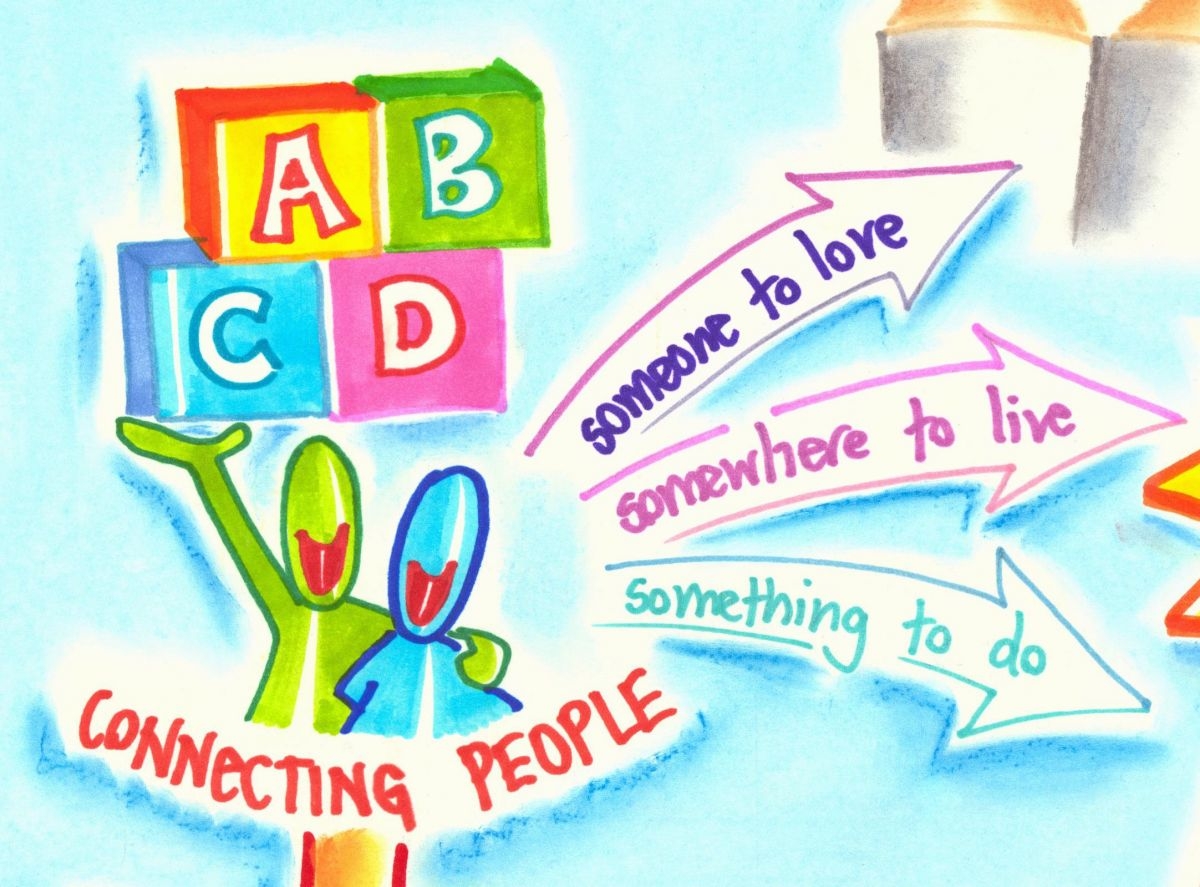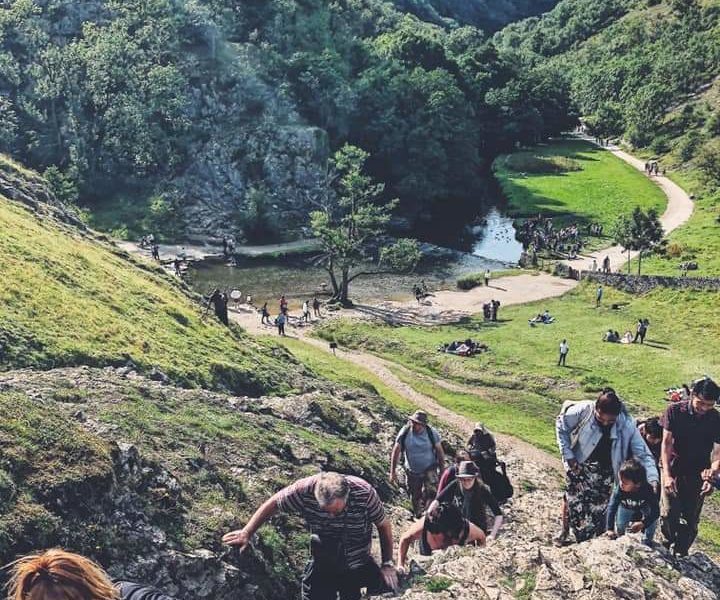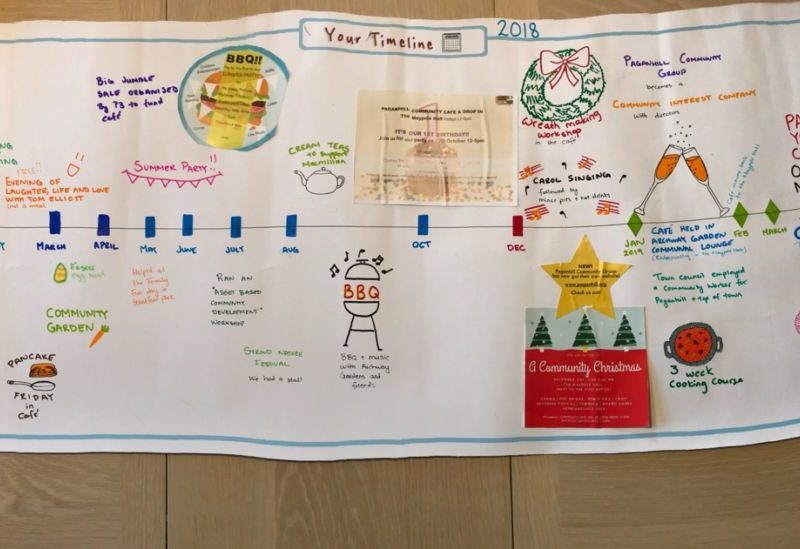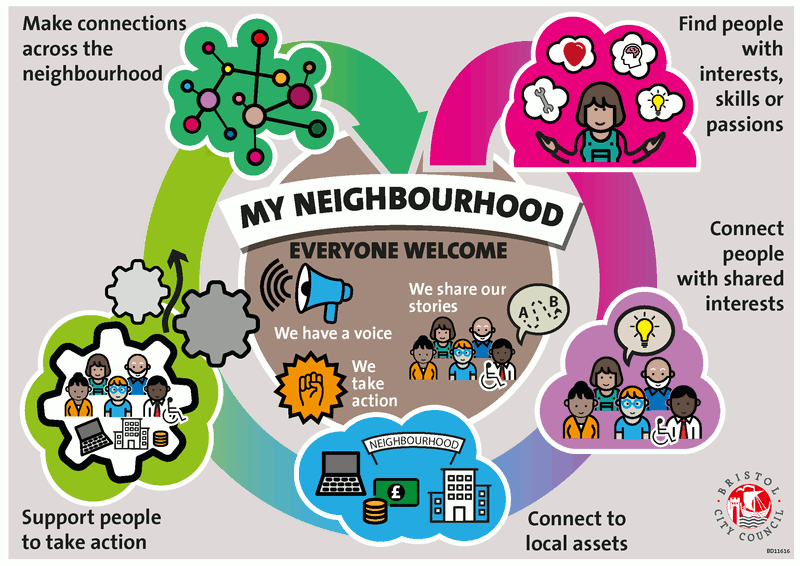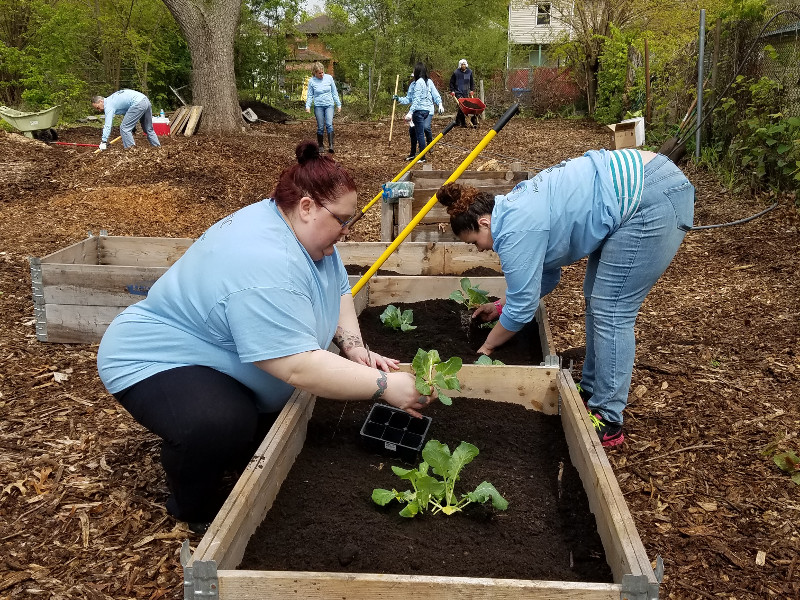Asset Based Community Development (ABCD) is an approach to sustainable community-driven development. Beyond the mobilisation of a particular community, it is concerned with how to link micro-assets to the macro-environment. Asset Based Community Development’s premise is that communities can drive the development process themselves by identifying and mobilizing existing, but often unrecognised assets. Thereby responding to challenges and creating local social improvement and economic development.
This page will describe ABCD through five key aspects.
- Asset Based Approach
- Deficit Based vs Asset Based Comparison
- Power of Associations
- Principles for facilitating Asset Based Community Development
- Asset Based Community Development in Practice
Asset Based Approach
Asset Based Community Development builds on the assets that are found in the community and mobilizes individuals, associations, and institutions to come together to realise and develop their strengths. This makes it different to a Deficit Based approach that focuses on identifying and servicing needs. From the start an Asset Based approach spends time identifying the assets of individuals, associations and institutions that form the community. The identified assets from an individual are matched with people or groups who have an interest in or need for those strengths. The key is beginning to use what is already in the community. Then to work together to build on the identified assets of all involved.
The first key method of the ABCD approach is that development begins with the recognition of asset categories that can be uncovered in any community and place. When applying ABCD principles communities are not thought of as complex masses of needs and problems, but rather diverse and capable webs of gifts and assets. Each community has a unique set of skills and capacities it can channel for community development.
Asset Based Community Development categorizes asset inventories into five groups, Individuals, Associations, Institutions, Place Based and Connections.
Individuals – Everyone has assets and gifts.
At the centre are residents of the community who all have gifts and skills. Individual gifts and assets need to be recognized and identified. In community development you cannot do anything with people’s needs, only their assets. Deficits or needs are only useful to institutions.
Associations – People discover each other’s gifts.
Small informal groups of people, such as clubs, working with a common interest as volunteers are called associations in ABCD, and are critical to community mobilization. They don’t control anything; they are just coming together around a common interest by their individual choice.
Institutions – People organised around assets.
Paid groups of people that generally are professionals who are structurally organized are called institutions. They include government agencies and private business, as well as schools, etc. They can all be valuable resources. The assets of these institutions help the community capture valuable resources and establish a sense of civic responsibility.
Place Based Assets – People live here for a reason.
Land, buildings, heritage, public and green spaces are all examples of assets for the community. Every place where people choose to be was chosen for good reasons, and whilst people remain those reasons remain. A place might be a centre of natural resources, a hub of activity, living skills, transit connection or marketplace. Whatever the strengths of a place are, the people of the community will be the closest to understanding it.
Connections – Individuals connect into a community.
Asset Based Community Development recognises that the exchange between people sharing their gifts and assets creates connections, and these connections are a vital asset to the community. People whose gift is to find and create these connections are called connectors. It takes time to find out about individuals; this is normally done through building relationships, person by person. The social relationships, networks and trust form the social capital of a community. ABCD recognises the value of these assets, and is a practical application of building relationships to increase social capital.
Deficit Based vs Asset Based
In the past when a person had a need they went to their neighbourhood for assistance. But this has shifted today to the belief that the neighbour does not have the skills to help them. Therefore they must seek services and go to a professional for assistance. In so doing, reinforcing the form of system that divides people into providers and recipients.
| Deficit Based | Asset Based |
| Problems Blame What’s missing Scarcity Risks Needs Control-outside in Top-down Do to Clients & passive receivers Provider-led |
Possibilities Shared ownership What’s there Abundance Courageous leadership Strengths, capacities, assets Lead by stepping back Inside-out Do with & enable to do Co-producers & active creators Citizen-led |
| Different Perspectives of Deficit Based vs Asset Based | |
Professionalised deficit based service providers have made clients of the poor. People are distanced from the support of their neighbours, who now think that they are too removed and unqualified to help. This leads to isolation of the individuals. When in difficulty people are pressured to identify themselves by their special needs that can only be validated and serviced by outside agency. But within the ABCD process this can be changed through the process of recognising community assets and changing assumptions and intent accordingly.
| Deficit Based | Asset Based | |
| Purpose | Changing community through increased services | Changing community through citizen involvement |
| Method | Institutional reform | Citizen-centred production |
| Accountability | Leaders are professional staff, accountable to institutional stakeholders. | Leaders area widening circles of volunteer citizens. Accountable to the community. |
| Significance of Assets | Assets are system inputs. Asset mapping is data collection. | Assets are relationships to be discovered and connected. Asset mapping is self-realization and leadership development. |
| Production Resource | Money is the key resource. Falls apart without money. | Relationships are the key resource. Falls apart when money becomes the focus. |
| Operating Challenge | How do we get citizens involved? | How do we channel and build on all this citizen participation? |
| System Dynamic | Tends to spread itself thinner over time. | Tends to snowball over time. |
| Evaluation | Success is service outcomes, measured mostly by institutional stakeholders. | Success is capacity, measured mostly by relationships. |
| Deficit Based Process vs Sustainable Community Development Asset Based Approach | ||
Power of Associations
The second key method of Asset Based Community Development is that action is realised through the local associations who should drive the community development process and leverage additional support and entitlements.
| Associations | Institutions | |
| How Governed | Power by consent | Directors following policy |
| How Decisions Made | Choice of members | Managing executives |
| How Designed | By members for themselves | To meet production demands |
| Who Decides What To Do | Members | Contractors |
| Who Runs | Member volunteers | Employees |
| Who Are Beneficiaries | Members | Contractor, employees, directors and consumers |
| Function | To do more together | To do more for less |
| What drives | Capacity of members | Drive to meet contractual obligations |
| Amount of Control | Voluntary agreement | Tight hierarchical control |
| Strengths | Fun, creative and adaptable | Reliable repetitive production |
| Associations vs Institutions | ||
These associations are the vehicles through which all of a community’s assets can be identified and connected to one another in ways that multiply their power and effectiveness. Users of the ABCD approach are deliberate in their intentions to lead by stepping back. Existing associations and networks (whether formal or informal) are assumed to be the source of constructive energy in the community. Community-driven development is done rather than development driven by external agencies that divide their capacity and expertise between service provision and the priorities of their continuing existence.
ABCD draws out strengths and successes in a community’s shared history as its starting point for change. Among all the assets that exist in the community, ABCD pays particular attention to the assets inherent in social relationships, as evident in formal and informal associations and networks.
ABCD’s community-driven approach is in keeping with the principles and practice of participatory approaches development, where active participation and empowerment (and the prevention of disempowerment) are the basis of practice. It is a strategy directed towards sustainable, economic and social development that is community-driven.
Principles for facilitating Asset Based Community Development
Most communities address social and economic problems with only a small amount of their total capacity. A large amount of the community capacity is often diverted into meeting the service and eligibility requirements of external deficit focused provision. This capacity is needed internally by the community as it reacts to challenges and seeks to lead its own development. This is the challenge and opportunity of community engagement.
Everyone Has Gifts
With rare exception; people can contribute and want to contribute. Everyone in a community has something to offer. There is no one who is not needed. Gifts must be discovered.
Relationships Build a Community
See them, make them, and utilize them. An intentional effort to build and nourish relationships is the core of ABCD and of all community building.
Citizens at the Centre
It is essential to engage the wider community as actors (citizens) not just as recipients of services (clients).
Leaders Involve Others as Active Members of the Community
Leaders from the wider community of voluntary associations, congregations, neighbourhoods, and local business, can engage others from their sector. This form of leadership utilises relationships, inclusion, showing and sharing to lead involvement based on trust.
People Care About Something
Agencies and neighbourhood groups often feel trapped by perceived apathetic responses. Apathy is a sign of bad listening. People in communities are motivated to act. The challenge is to discover what their motivation is.
Motivation to Act
People act on certain themes they feel strongly about, such as; concerns to address, dreams to realize, and personal talents to contribute. Every community is filled with invisible “motivation for action” that must be identified. Listen for it.
Listening Conversation
One-on-one dialogue or small group conversations are ways of discovering motivation and invite participation. Forms, surveys and asset maps can be useful to guide intentional listening and relationship building but cannot fill the void left by its absence.
Ask, Ask, Ask
Asking and inviting are key community-building actions. It is integral to showing that people have been listened to and their gifts are recognised. “Join us. We need you.” This is the song of community.
Asking Questions Rather Than Giving Answers Invites Stronger Participation
People in communities are usually asked to follow an outside expert’s answers for their community problems. A more powerful way to engage people is to invite communities to address ‘questions’ and lead finding their own answer, changing the role of agencies to following up with help.
A Citizen-Centred “Inside-Out” Organization is the Key to Community Engagement
A “citizen-centred” organization is one where local people control the organization and set the organization’s agenda.
Institutions Have Reached Their Limits in Problem-Solving
All institutions such as government, not-for-profits, and businesses are stretched thin in their ability to solve community problems. They can not be successful without engaging the rest of the community in solutions.
Institutions as Servants
Local people are better than outside programs in engaging the wider community. Leaders in institutions have an essential role in community-building as they lead by “stepping back,” creating opportunities for citizenship, letting people show they care, and engaging in real democracy.
Asset Based Community Development in Practice
ABCD is an approach built on tried and tested methods from sustainable community development practice. It is not a set formula that can be prescribed in a one size fits all manner. Here are basic common steps reflecting the experience and principles of applying an asset based approach.
1) Collect stories
Stories are collections of the cultural capital of a community. The listening conversation can engage people’s experience of successful activities that will help to uncover the gifts, skills, talents and assets within the community. From the stories, what people care about and their motivations to act can be discovered. Importantly this form of inquiry does not diminish but reinforces citizens as the centre of their community.
2) Bring together a core group
From the stories, people will emerge who have shown commitment and leadership in the past or who are currently taking a leadership role. Next bring together a group of these committed individuals who are interested in exploring the community’s assets, identifying opportunities and leading developmental action. Engaged and motivated to act on what they care about, using their strengths and gifts, these individuals will open networks of relationships inside the community.
3) Map the gifts, capacities and assets of individuals, associations, and local institutions
Citizens and their associations do the asset mapping so that they build new relationships, learn more about the contributions and talents of community members, identify connections that open opportunities and enable change. The objectives are:
Identifying associations
A list of associations can then be clustered by type and those associations most likely to participate in working together for a common purpose can be identified. In the process of identifying associations, the list of leaders in the community also expands.
Identifying individual gifts, skills, and capacities
The focus is to show people that their abilities and contributions are appreciated. A capacity inventory will be developed listing these capacities in categories such as community-building, enterprise, teaching, artistic or other skills. The categories should reflect the self identified strengths of the community, and not an external requirements list.
Identifying the assets of local institutions
This includes government services, non-government service providers and private sector businesses. These assets could be the services they provide, meeting places, the equipment and other supplies they can make available, communications links and staff who can envision the wider benefits for the whole community of stronger relationships.
Identifying physical assets and natural resources
This is a list of the potentials of a place, in which new ideas and re-imaginings can emerge. It is not a dry list for valuations, but revealing and understanding of the foundations on which development can be built. Because access and use has different conditions those which are communally owned and managed should be identified separately from those which are individually owned and managed.
Mapping the local economy
Provision of services has led to a distancing of community understanding from how their needs can be met. This process returns knowledge to people in the community of how the local economy works. With this people can see how well local resources are maximised for local economic benefit, and evaluate plans for economic development that can enhance local provision for externally provided services that drain resource away from the local economy.
4) Find and engage connectors who can build relationships
Lasting change comes from within the community and local people know what needs to change. Possibly the most vital step of Asset Based Community Development is encouraging the building of new relationships and strengthening and expanding existing ones. This is the heart of community building, and will lead to the immeasurable benefit that communities protect and support what they create.
5) Ask the gathered community to lead the creation of a community vision and plan
Asset Based Community Development’s core idea is that communities can drive the development process themselves by identifying and mobilizing existing, but often unrecognised assets. This requires a strong commitment to community driven efforts through active citizenship and participatory democratic methods. The community can meet the challenge to match assets with opportunities and decide their organising theme. A concrete, achievable and understood activity should be selected within that organising theme to begin working on right away.
6) Engage the self mobilisation of the community’s assets by action applied through association.
When people know what to do to succeed, know what success looks like, can see where to start and that it can be achieved within available resources, the chosen activity will have have a unifying and strengthening outcome. This creates the self-mobilisation as an ongoing process. Associations lead transformative efforts for local social and economic development. This leads to information sharing and realisation of what can further be achieved through new connections and association. From this emerges larger community-wide connected associations with common purpose.
7) Lever knowledge of the community’s assets and strengths to secure investments and resources needed from outside the community for community-driven development.
Institutions lead by “stepping back” into a supporting and helping role, leaving decision-making to associational leaders to facilitate within the community. Achieving a community vision begins with people that realise the power of their associations and accepting the challenge of making things happen. External resources are not sought until local resources have been utilised and clear understanding of what is needed is known. This crucially changes the dynamic of community interaction with institutions, from the community being under pressure to shape themselves to the externally provided services being offered to now utilising resource and investment that creates sustainable community development.

